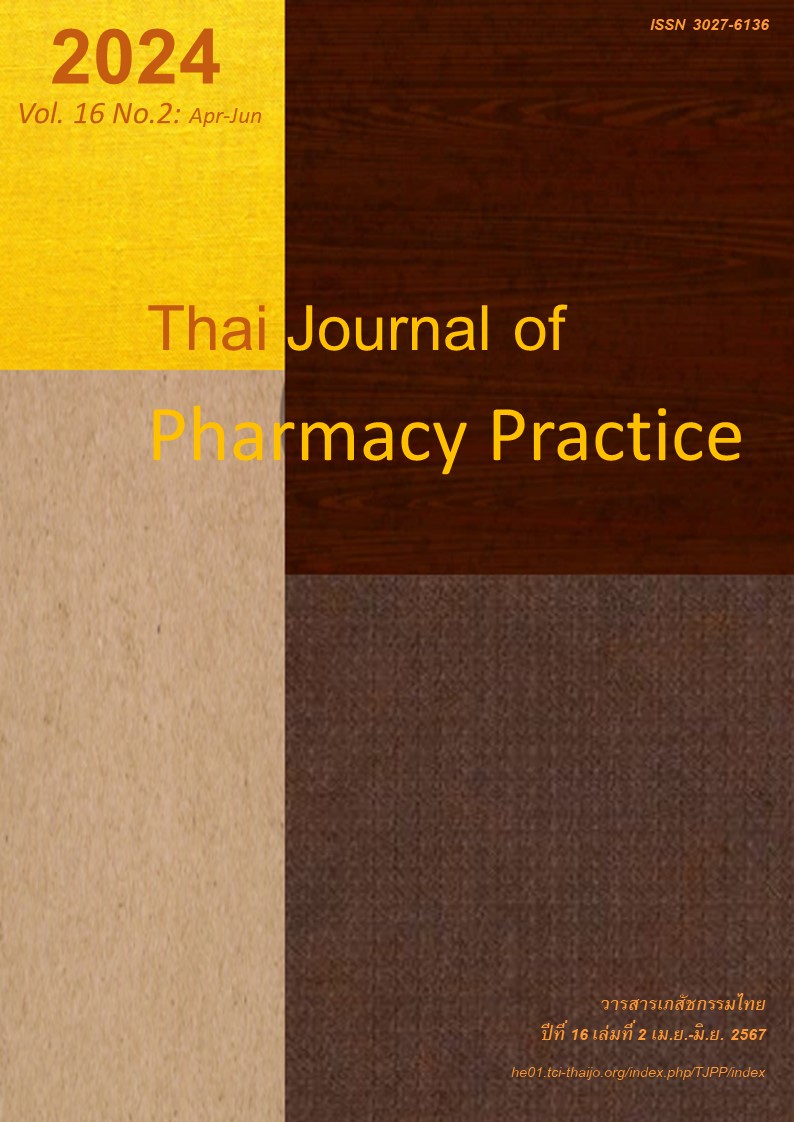ความสมเหตุผลของการใช้ยาปฏิชีวนะในบาดแผลสดจากอุบัติเหตุ: กรณีโรงพยาบาลชุมชนแห่งหนึ่งในจังหวัดขอนแก่น
Main Article Content
บทคัดย่อ
วัตถุประสงค์: เพื่อหาความชุกของการสั่งใช้ยาปฏิชีวนะในกรณีบาดแผลสดจากอุบัติเหตุประเมินการสั่งใช้ยาปฏิชีวนะดังกล่าวตามแนวทางการใช้ยาอย่างสมเหตุผล และความชุกของการติดเชื้อของบาดแผลหลังการรักษา วิธีการ: การศึกษาแบบไปข้างหน้าครั้งนี้ทำในผู้ป่วยที่มารับการรักษาบาดแผลสดจากอุบัติเหตุ ณ โรงพยาบาลเปือยน้อย จังหวัดขอนแก่น ระหว่างวันที่ 1 ธันวาคม 2562 ถึง 31 พฤษภาคม 2563 การศึกษาเก็บข้อมูลจากเวชระเบียนผู้ป่วยอิเล็กทรอนิกส์และการสัมภาษณ์ผู้ป่วย ได้แก่ ข้อมูลทั่วไปของผู้ป่วย ข้อมูลลักษณะบาดแผล ข้อมูลการรักษาด้วยยา และผลลัพธ์ทางคลินิกที่ 14 วันถัดมา ได้แก่ ผลการรักษาและการติดเชื้อของบาดแผล ผลการวิจัย: ผู้ป่วย 360 รายเข้าร่วมการศึกษา พบการสั่งใช้ยาปฏิชีวนะในผู้ป่วยร้อยละ 37.5 ยาปฏิชีวนะที่ใช้มากที่สุดร้อยละ 63.7 คือ dicloxacillin ระยะเวลาของการใช้ยาเฉลี่ย 5.1 ± 1.6 วัน การสั่งใช้ยามีความสมเหตุผลร้อยละ 30.8 การใช้ยาอย่างไม่เหมาะสม 249 ครั้ง ประกอบด้วยการไม่สั่งใช้ยาที่จำเป็น ระยะเวลาไม่เหมาะสม การสั่งใช้ยาโดยไม่จำเป็น และชนิดของยาไม่เหมาะสม ในผู้ป่วยร้อยละ 54.6, 27.7, 16.1 และ 1.6 ตามลำดับ การศึกษาพบแผลติดเชื้อในผู้ป่วยร้อยละ 1.67 สรุป: ร้อยละของการใช้ยาปฏิชีวนะในผู้ป่วยบาดแผลสดจากอุบัติเหตุของโรงพยาบาลผ่านเกณฑ์การใช้ยาปฏิชีวนะอย่างรับผิดชอบที่กำหนดไว้ที่น้อยกว่าร้อยละ 40 แต่การสั่งใช้ส่วนใหญ่ไม่สมเหตุผลและอัตราการเกิดแผลติดเชื้อต่ำ
Article Details

อนุญาตภายใต้เงื่อนไข Creative Commons Attribution-NonCommercial-NoDerivatives 4.0 International License.
ผลการวิจัยและความคิดเห็นที่ปรากฏในบทความถือเป็นความคิดเห็นและอยู่ในความรับผิดชอบของผู้นิพนธ์ มิใช่ความเห็นหรือความรับผิดชอบของกองบรรณาธิการ หรือคณะเภสัชศาสตร์ มหาวิทยาลัยสงขลานครินทร์ ทั้งนี้ไม่รวมความผิดพลาดอันเกิดจากการพิมพ์ บทความที่ได้รับการเผยแพร่โดยวารสารเภสัชกรรมไทยถือเป็นสิทธิ์ของวารสารฯ
เอกสารอ้างอิง
Prevaldi C, Paolillo C, Locatelli C, Ricci G, Catena F, Ansaloni L, et al. Management of traumatic wounds in the emergency department: position paper from the Academy of Emergency Medicine and Care (AcEMC) and the World Society of Emergency Surgery (WSES). World J Emerg Surg 2016; 11: 30.
Sirijatuphat R, Siritongtaworn P, Sripojtham Rn V, Boonyasiri A, Thamlikitkul V. Bacterial contamination of fresh traumatic wounds at trauma center, Siriraj hospital, Bangkok, Thailand. J Med Assoc Thai 2014; 97: S20–5.
Sirijatuphat R, Choochan T, Siritongtaworn P, Sripojtham Rn V, Thamlikitkul V. Implementation of antibiotic use guidelines for fresh traumatic wound at Siriraj hospital. J Med Assoc Thai. 2015; 98: 245–52.
Zehtabchi S. The role of antibiotic prophylaxis for prevention of infection in patients with simple hand lacerations. Ann Emerg Med. 2007; 49: 682–9.
Cowell DL, Harvey M, Cave G. Antibiotic prophylaxis at triage for simple traumatic wounds: a pilot study. Eur J Emerg Med. 2011; 18: 279–81.
Cummings P, del Beccaro MA. Antibiotics to prevent infection of simple wounds: a meta-analysis of randomized studies. Am J Emerg Med. 1995; 13: 396–400.
Chaiyasong C, Tiyapak P, Wongsriya A, Chaiyasong S. Types of wounds and patterns of antibiotic use in trauma patients in Mahasarakham hospital. Journal of Health Systems Research. 2019; 13: 117–24.
The Sub-Committee on Rational Drug Use. Rational drug use hospital manual. Bangkok: The Agricultural Cooperative Federation of Thailand; 2015.
Ministry of Public Health. Health data center [online]. 2020 [cited Sep 14, 2022]. Available from: kkn.hdc.moph.go.th/hdc/reports/page_kpi.php?flag_kpi_level=1&flag_kpi_year=2020.
Sungsanah A, Arunkeeree A, Phuttharaksa P, Nimnaul B. Infectious rate of fresh traumatic wounds class I after following the implementation of the guidelines for fresh traumatic wounds at Bangkhla hospital, Chachoengsao province. Journal of Primary Care and Family Medicine 2021; 3: 81–91.
Chaosakai R. Rational drug use evaluation of antibiotic in fresh trauma wound in Chaiwan hospital, Udonthani. Chaiyaphum Medical Journal. 2021; 41: 1–10.
Berwald N, Khan F, Zehtabchi S. Antibiotic prophylaxis for ED patients with simple hand lacerations: a feasibility randomized controlled trial. Am J Emerg Med. 2014; 32: 768–71.


